设计模式的分类:
·创建型
·结构型
·行为型
1.创建型模式
·简单工厂模式 (Simple Factory)
·工厂方法模式 (Factory Method)
·抽象工厂模式 (Abstract Factory)
·建造者模式 (Builder)
·原型模式 (Prototype)
·单例模式 (Singleton)
2.结构型模式
·外观模式 (Facade)
·适配器模式 (Adapter)
·代理模式 (Proxy)
·装饰模式 (Decorator)
·桥接模式 (Bridge)
·组合模式 (Composite)
·享元模式 (Flyweight)
3.行为型模式
·模板方法模式 (Template Method)
·观察者模式 (Observer)
·状态模式 (State)
·策略模式 (Strategy)
·职责链模式 (Chain of Responsibility)
·命令模式 (Command)
·访问者模式 (Visitor)
·调停者模式 (Mediator)
·备忘录模式 (Memento)
·迭代器模式 (Iterator)
·解释器模式 (Interpreter)
posted @
2011-05-01 18:55 unixfy 阅读(194) |
评论 (0) |
编辑 收藏搜索引擎会通过日志文件把用户每次检索使用的所有检索串都记录下来,每个查询串的长度为1-255字节。
假设目前有一千万个记录(这些查询串的重复度比较高,虽然总数是1千万,但如果除去重复后,不超过3百万个。一个查询串的重复度越高,说明查询它的用户越多,也就是越热门。请你统计最热门的10个查询串,要求使用的内存不能超过1G。
先统计所有查询的次数,所有查询有 300 万个,255 * 300 * 10000B = 765 MB,可以存入内存。这里使用 STL 中的 map。所得时间复杂度为 O(NlogM),N 为所有的查询,包括重复的,M 为不重复的查询。更好的方法是用散列。
然后遍历 map,维护一个大小为 10 的集合,在遍历 map 时,比较当前查询的出现次数与集合中出现次数最小的查询的出现此时比较,如果大于,将当前查询替换到集合中。
这里的集合还是用的 map,时间复杂度为 O(MlogK),这里 K = 10。
总的时间复杂度为 O(NlogM) + O(MlogK)
也可以将这个过程合二为一。即每次在统计的过程中,查询大小为 K 的集合。如果符合条件,则将当前查询替换到集合中。但是还要考虑实时更新集合中的元素。
这种方法的时间复杂度为 O(N(logM + logK + K))。
由于第二种方法还得考虑实时更新。效率远没有第一种方案高。
实现:
1 #include <iostream>
2 #include <fstream>
3 #include <map>
4 #include <string>
5 using namespace std;
6
7 void statistics(map<string, int>& data, const string& query)
8 {
9 ++data[query];
10 }
11
12 void findTopK(multimap<int, string>& topK, int k, const map<string, int>& data)
13 {
14 topK.clear();
15 for (map<string, int>::const_iterator cit = data.begin(); cit != data.end(); ++cit)
16 {
17 if (topK.size() < k)
18 {
19 topK.insert(make_pair(cit->second, cit->first));
20 }
21 else
22 {
23 if (cit->second > topK.begin()->first)
24 {
25 topK.erase(topK.begin());
26 topK.insert(make_pair(cit->second, cit->first));
27 }
28 }
29 }
30 }
31
32 int main()
33 {
34 ifstream fin("queryfile.txt");
35 map<string, int> data;
36 multimap<int, string> top10;
37 string query;
38 while (getline(fin, query))
39 {
40 statistics(data, query);
41 }
42
43 //for (map<string, int>::const_iterator cit = data.begin(); cit != data.end(); ++cit)
44 //{
45 // cout << cit->first << '\t' << cit->second << endl;
46 //}
47
48 //cout << endl;
49 findTopK(top10, 10, data);
50
51 for (multimap<int, string>::const_reverse_iterator cit = top10.rbegin(); cit != top10.rend(); ++cit)
52 {
53 cout << cit->second << '\t' << cit->first << endl;
54 }
55
56 return 0;
57 }
http://blog.donews.com/jiji262/2011/03/baidu_top_k_interview/http://blog.redfox66.com/post/2010/09/23/top-k-algoriyhm-analysis.aspxhttp://blog.csdn.net/jasonblog/archive/2010/08/19/5825026.aspx
posted @
2011-04-30 18:06 unixfy 阅读(211) |
评论 (0) |
编辑 收藏来自于《大话设计模式》
访问者模式(Visitor):
表示一个作用于某对象结构中的个元素的操作。它是你可以在不改变各元素的类的前提下定义作用于这些元素的新操作。
行为型
UML 类图:
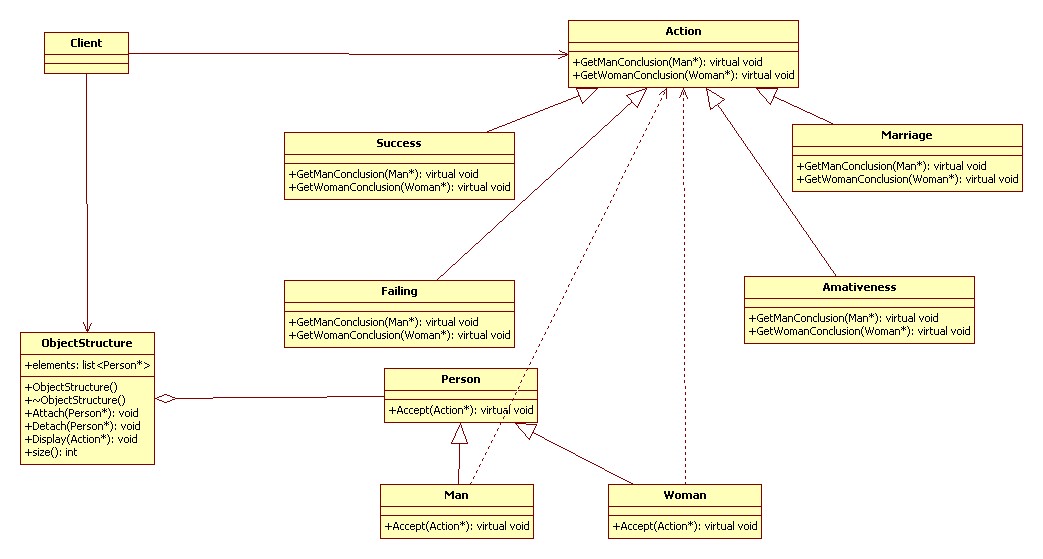
代码实现 C++:
1 #include <iostream>
2 #include <list>
3 #include <algorithm>
4 #include <string>
5 using namespace std;
6
7 class Action;
8
9 class Person
10 {
11 protected:
12 string name;
13 public:
14 Person(const string& s = "Person") : name(s) {}
15 virtual void Accept(Action* visitor) = 0;
16 virtual string getName()
17 {
18 return name;
19 }
20 };
21
22 class Man;
23 class Woman;
24
25 class Action
26 {
27 protected:
28 string name;
29 public:
30 Action(const string& s = "Action") : name(s) {}
31 virtual void GetManConclusion(Man* m) = 0;
32 virtual void GetWomanConclusion(Woman* w) = 0;
33 };
34
35 class Man : public Person
36 {
37 public:
38 Man(const string& s = "Man") : Person(s) {}
39 virtual void Accept(Action* visitor)
40 {
41 visitor->GetManConclusion(this);
42 }
43 };
44
45 class Woman : public Person
46 {
47 public:
48 Woman(const string& s = "Woman") : Person(s) {}
49 virtual void Accept(Action* visitor)
50 {
51 visitor->GetWomanConclusion(this);
52 }
53 };
54
55 class Success : public Action
56 {
57 public:
58 Success(const string& s = "Success") : Action(s) {}
59 virtual void GetManConclusion(Man* m)
60 {
61 cout << name << endl;
62 cout << m->getName() << endl;
63 cout << "1" << endl;
64 }
65 virtual void GetWomanConclusion(Woman* w)
66 {
67 cout << name << endl;
68 cout << w->getName() << endl;
69 cout << "2" << endl;
70 }
71 };
72
73 class Failing : public Action
74 {
75 public:
76 Failing(const string& s = "Failing") : Action(s) {}
77 virtual void GetManConclusion(Man* m)
78 {
79 cout << name << endl;
80 cout << m->getName() << endl;
81 cout << "3" << endl;
82 }
83 virtual void GetWomanConclusion(Woman* w)
84 {
85 cout << name << endl;
86 cout << w->getName() << endl;
87 cout << "4" << endl;
88 }
89 };
90
91 class Amativeness : public Action
92 {
93 public:
94 Amativeness(const string& s = "Amativeness") : Action(s) {}
95 virtual void GetManConclusion(Man* m)
96 {
97 cout << name << endl;
98 cout << m->getName() << endl;
99 cout << "5" << endl;
100 }
101 virtual void GetWomanConclusion(Woman* w)
102 {
103 cout << name << endl;
104 cout << w->getName() << endl;
105 cout << "6" << endl;
106 }
107 };
108
109 class Marriage : public Action
110 {
111 public:
112 Marriage(const string& s = "Marriage") : Action(s) {}
113 virtual void GetManConclusion(Man* m)
114 {
115 cout << name << endl;
116 cout << m->getName() << endl;
117 cout << "7" << endl;
118 }
119 virtual void GetWomanConclusion(Woman* w)
120 {
121 cout << name << endl;
122 cout << w->getName() << endl;
123 cout << "8" << endl;
124 }
125 };
126
127 class ObjectStructure
128 {
129 private:
130 list<Person*> elements;
131 public:
132 ObjectStructure() {}
133 ~ObjectStructure()
134 {
135 for (list<Person*>::iterator iter = elements.begin(); iter != elements.end(); ++iter)
136 {
137 delete (*iter);
138 }
139 }
140 void Attach(Person* element)
141 {
142 elements.push_back(element);
143 }
144 void Detach(Person* element)
145 {
146 list<Person*>::iterator iter = find(elements.begin(), elements.end(), element);
147 if (iter != elements.end())
148 {
149 elements.erase(iter);
150 }
151 }
152 void Display(Action* visitor)
153 {
154 for (list<Person*>::iterator iter = elements.begin(); iter != elements.end(); ++iter)
155 {
156 (*iter)->Accept(visitor);
157 }
158 }
159 int size()
160 {
161 return elements.size();
162 }
163 };
164
165 int main()
166 {
167 ObjectStructure o;
168 o.Attach(new Man);
169 o.Attach(new Woman);
170
171 cout << o.size() << endl;
172
173 Success* v1 = new Success;
174 o.Display(v1);
175 Failing* v2 = new Failing;
176 o.Display(v2);
177 Amativeness* v3 = new Amativeness;
178 o.Display(v3);
179 Marriage* v4 = new Marriage;
180 o.Display(v4);
181
182 delete v4;
183 delete v3;
184 delete v2;
185 delete v1;
186
187 return 0;
188 }
posted @
2011-04-30 15:21 unixfy 阅读(466) |
评论 (0) |
编辑 收藏来自于《大话设计模式》
解释器模式(Interpreter):
给定一个语言,定义它的文法的一种表示,并定义一个解释器,这个解释器使用该表示来解释语言中的句子。
行为型
UML 类图:
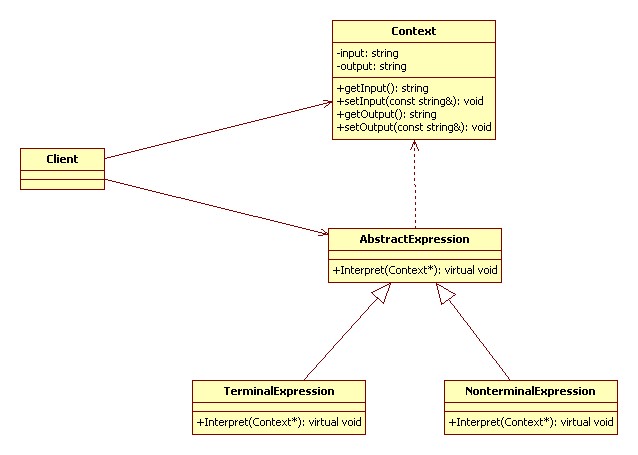
代码实现 C++:
1 #include <iostream>
2 #include <string>
3 #include <list>
4 using namespace std;
5
6 class Context
7 {
8 private:
9 string input;
10 string output;
11 public:
12 string getInput()
13 {
14 return input;
15 }
16 void setInput(const string& s)
17 {
18 input = s;
19 }
20 string getOutput()
21 {
22 return output;
23 }
24 void setOutput(const string& s)
25 {
26 output = s;
27 }
28 };
29
30 class AbstractExpression
31 {
32 public:
33 virtual void Interpret(Context* context) = 0;
34 };
35
36 class TerminalExpression : public AbstractExpression
37 {
38 public:
39 virtual void Interpret(Context* context)
40 {
41 context->setOutput("终端解释器:" + context->getInput());
42 cout << context->getOutput() << endl;
43 }
44 };
45
46 class NonterminalExpression : public AbstractExpression
47 {
48 public:
49 virtual void Interpret(Context* context)
50 {
51 context->setOutput("非终端解释器:" + context->getInput());
52 cout << context->getOutput() << endl;
53 }
54 };
55
56 int main()
57 {
58 Context* context = new Context;
59 context->setInput("abc");
60 list<AbstractExpression*> lae;
61
62 lae.push_back(new TerminalExpression);
63 lae.push_back(new NonterminalExpression);
64 lae.push_back(new TerminalExpression);
65 lae.push_back(new TerminalExpression);
66
67 for (list<AbstractExpression*>::iterator iter = lae.begin(); iter != lae.end(); ++iter)
68 {
69 (*iter)->Interpret(context);
70 }
71
72 for (list<AbstractExpression*>::iterator iter = lae.begin(); iter != lae.end(); ++iter)
73 {
74 delete (*iter);
75 }
76 delete context;
77
78 return 0;
79 }
posted @
2011-04-30 14:32 unixfy 阅读(955) |
评论 (2) |
编辑 收藏来自于《大话设计模式》
享元模式(Flyweight):
运用共享技术有效地支持大量细粒度的对象。
结构型
UML 类图:
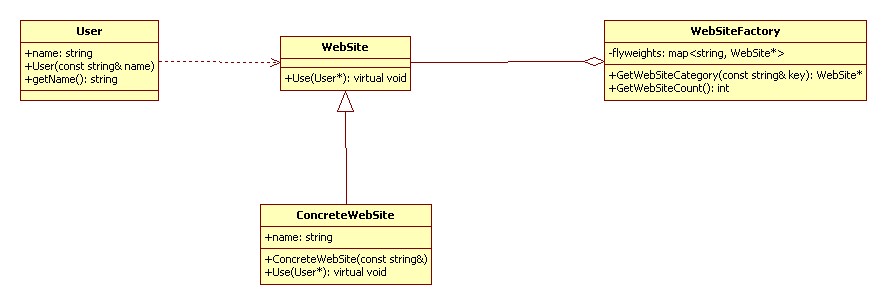
代码实现 C++:
1 #include <iostream>
2 #include <map>
3 #include <string>
4 using namespace std;
5
6 class User
7 {
8 private:
9 string name;
10 public:
11 User(const string& s) : name(s) {}
12 string getName()
13 {
14 return name;
15 }
16 };
17
18 class WebSite
19 {
20 public:
21 WebSite() {}
22 virtual ~WebSite() {}
23 virtual void Use(User* user) = 0;
24 };
25
26 class ConcreteWebSite : public WebSite
27 {
28 private:
29 string name;
30 public:
31 ConcreteWebSite() {}
32 virtual ~ConcreteWebSite() {}
33 ConcreteWebSite(const string& s) : name(s){}
34 virtual void Use(User* user)
35 {
36 cout << "网站分类:" << name << " 用户:" << user->getName() << endl;
37 }
38 };
39
40 class WebSiteFactory
41 {
42 private:
43 map<string, WebSite*> flyweights;
44 public:
45 ~WebSiteFactory()
46 {
47 for (map<string, WebSite*>::iterator iter = flyweights.begin(); iter != flyweights.end(); ++iter)
48 {
49 delete iter->second;
50 }
51 }
52 WebSite* GetWebSiteCategory(const string& key)
53 {
54 map<string, WebSite*>::iterator iter = flyweights.find(key);
55 if (iter != flyweights.end())
56 {
57 return iter->second;
58 }
59 else
60 {
61 flyweights.insert(make_pair(key, new ConcreteWebSite(key)));
62 return flyweights[key];
63 }
64 }
65 int GetWebSiteCount()
66 {
67 return flyweights.size();
68 }
69 };
70
71 int main()
72 {
73 WebSiteFactory* f = new WebSiteFactory;
74 cout << f->GetWebSiteCount() << endl;
75 WebSite* fx = f->GetWebSiteCategory("产品展示");
76 cout << f->GetWebSiteCount() << endl;
77 User* user = new User("小菜");
78 fx->Use(user);
79 delete user;
80
81 WebSite* fy = f->GetWebSiteCategory("产品展示");
82 cout << f->GetWebSiteCount() << endl;
83 user = new User("大鸟");
84 fy->Use(user);
85 delete user;
86
87 WebSite* fz = f->GetWebSiteCategory("产品展示");
88 cout << f->GetWebSiteCount() << endl;
89 user = new User("娇娇");
90 fz->Use(user);
91 delete user;
92
93 WebSite* fl = f->GetWebSiteCategory("博客");
94 cout << f->GetWebSiteCount() << endl;
95 user = new User("老顽童");
96 fl->Use(user);
97 delete user;
98
99 WebSite* fm = f->GetWebSiteCategory("博客");
100 cout << f->GetWebSiteCount() << endl;
101 user = new User("桃谷六仙");
102 fm->Use(user);
103 delete user;
104
105 WebSite* fn = f->GetWebSiteCategory("博客");
106 cout << f->GetWebSiteCount() << endl;
107 user = new User("南海鳄神");
108 fn->Use(user);
109 delete user;
110
111 cout << "网站分类总数为:" << f->GetWebSiteCount() << endl;
112 delete f;
113 return 0;
114 }
posted @
2011-04-30 14:09 unixfy 阅读(246) |
评论 (0) |
编辑 收藏来自于《大话设计模式》
终结者模式(Mediator):
用一个中介对象来封装一系列的对象交互。中介者使各对象不需要显式地相互作用,从而使其耦合松散,而且可以独立地改变他们之间的交互。
行为型
UML 类图:
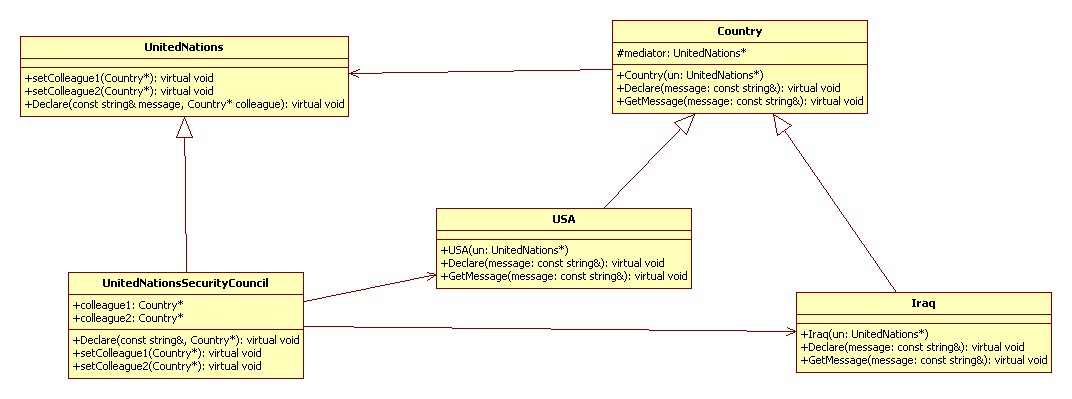
代码实现 C++:
1 #include <iostream>
2 #include <string>
3 using namespace std;
4
5 class Country;
6
7 class UnitedNations
8 {
9 public:
10 virtual void Declare(const string& message, Country* colleague) = 0;
11 virtual void setColleague1(Country* c1) = 0;
12 virtual void setColleague2(Country* c2) = 0;
13 };
14
15 class Country
16 {
17 protected:
18 UnitedNations* mediator;
19 public:
20 Country(UnitedNations* un) : mediator(un) {}
21 virtual void Declare(const string& message) = 0;
22 virtual void GetMessage(const string& message) = 0;
23 };
24
25 class USA : public Country
26 {
27 public:
28 USA(UnitedNations* un) : Country(un) {}
29 void Declare(const string& message)
30 {
31 mediator->Declare(message, this);
32 }
33 void GetMessage(const string& message)
34 {
35 cout << "美国获得对方信息:" << message << endl;
36 }
37 };
38
39 class Iraq : public Country
40 {
41 public:
42 Iraq(UnitedNations* un) : Country(un) {}
43 void Declare(const string& message)
44 {
45 mediator->Declare(message, this);
46 }
47 void GetMessage(const string& message)
48 {
49 cout << "伊拉克获得对方信息:" << message << endl;
50 }
51 };
52
53 class UnitedNationsSecurityCouncil : public UnitedNations
54 {
55 private:
56 Country* colleague1;
57 Country* colleague2;
58 public:
59 void setColleague1(Country* u)
60 {
61 colleague1 = u;
62 }
63 void setColleague2(Country* i)
64 {
65 colleague2 = i;
66 }
67 virtual void Declare(const string& message, Country* colleague)
68 {
69 if (colleague == colleague1)
70 {
71 colleague2->GetMessage(message);
72 }
73 else
74 {
75 colleague1->GetMessage(message);
76 }
77 }
78 };
79
80 int main()
81 {
82 UnitedNationsSecurityCouncil* UNSC = new UnitedNationsSecurityCouncil;
83 USA* c1 = new USA(UNSC);
84 Iraq* c2 = new Iraq(UNSC);
85
86 UNSC->setColleague1(c1);
87 UNSC->setColleague2(c2);
88
89 c1->Declare("不准研制核武器,否则要发动战争!");
90 c2->Declare("我们没有核武器,也不怕侵略!");
91
92 delete c2;
93 delete c1;
94 delete UNSC;
95
96 return 0;
97 }
posted @
2011-04-30 12:02 unixfy 阅读(520) |
评论 (0) |
编辑 收藏职责链模式(Chain of Responsibility):
使多个对象都有机会处理请求,从而避免请求的发送者和接受者之间的耦合关系。将这个对象连成一条链,并沿着这条链传递该请求,直到有一个对象处理它为止。
行为型
UML 类图:
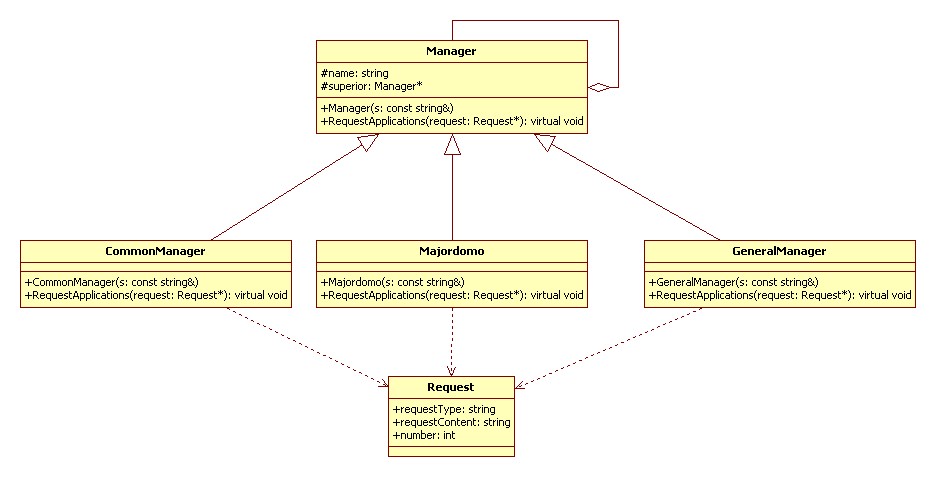
代码实现 C++:
1 #include <iostream>
2 #include <string>
3 using namespace std;
4
5 class Request
6 {
7 public:
8 string requestType;
9 string requestContent;
10 int number;
11 };
12
13 class Manager
14 {
15 protected:
16 string name;
17 Manager* superior;
18 public:
19 Manager(const string& s) : name(s), superior(0) {}
20 void SetSuperior(Manager* m)
21 {
22 superior = m;
23 }
24 virtual void RequestApplications(Request* request) = 0;
25 };
26
27 class CommonManager : public Manager
28 {
29 public:
30 CommonManager(const string& s) : Manager(s) {}
31 virtual void RequestApplications(Request* request)
32 {
33 if (request->requestType == "请假" && request->number <= 2)
34 {
35 cout << name << ": " << request->requestContent << " 数量 " << request->number << " 被批准!" << endl;
36 }
37 else if (superior != 0)
38 {
39 superior->RequestApplications(request);
40 }
41 else
42 {
43 cout << "不能得到处理!" << endl;
44 }
45 }
46 };
47
48 class Majordomo : public Manager
49 {
50 public:
51 Majordomo(const string& s) : Manager(s) {}
52 virtual void RequestApplications(Request* request)
53 {
54 if (request->requestType == "请假" && request->number <= 5)
55 {
56 cout << name << ": " << request->requestContent << " 数量 " << request->number << " 被批准!" << endl;
57 }
58 else if (superior != 0)
59 {
60 superior->RequestApplications(request);
61 }
62 else
63 {
64 cout << "不能得到处理!" << endl;
65 }
66 }
67 };
68
69 class GeneralManager : public Manager
70 {
71 public:
72 GeneralManager(const string& s) : Manager(s) {}
73 virtual void RequestApplications(Request* request)
74 {
75 if (request->requestType == "请假")
76 {
77 cout << name << ": " << request->requestContent << " 数量 " << request->number << " 被批准!" << endl;
78 }
79 else if (request->requestType == "加薪" && request->number <= 500)
80 {
81 cout << name << ": " << request->requestContent << " 数量 " << request->number << " 被批准!" << endl;
82 }
83 else if (request->requestType == "加薪" && request->number > 500)
84 {
85 cout << name << ": " << request->requestContent << " 数量 " << request->number << " 再说吧!" << endl;
86 }
87 else if (superior != 0)
88 {
89 superior->RequestApplications(request);
90 }
91 else
92 {
93 cout << "不能得到处理!" << endl;
94 }
95 }
96 };
97
98 int main()
99 {
100 CommonManager* jinli = new CommonManager("金利");
101 Majordomo* zongjian = new Majordomo("宗剑");
102 GeneralManager* zhongjingli = new GeneralManager("钟精励");
103
104 jinli->SetSuperior(zongjian);
105 zongjian->SetSuperior(zhongjingli);
106
107 Request* request = new Request;
108 request->requestType = "请假";
109 request->requestContent = "小菜请假";
110 request->number = 1;
111 jinli->RequestApplications(request);
112
113 Request* request2 = new Request;
114 request2->requestType = "请假";
115 request2->requestContent = "小菜请假";
116 request2->number = 4;
117 jinli->RequestApplications(request2);
118
119 Request* request3 = new Request;
120 request3->requestType = "加薪";
121 request3->requestContent = "小菜请求加薪";
122 request3->number = 500;
123 jinli->RequestApplications(request3);
124
125 Request* request4 = new Request;
126 request4->requestType = "加薪";
127 request4->requestContent = "小菜请求加薪";
128 request4->number = 1000;
129 jinli->RequestApplications(request4);
130
131 return 0;
132 }
posted @
2011-04-30 11:07 unixfy 阅读(204) |
评论 (0) |
编辑 收藏来自于《大话设计模式》
命令模式(Command):将一个请求封装为一个对象,从而使你可用不同的请求对客户进行参数化;对请求排队或记录请求日志,以及支持可撤销的操作。
行为型
UML 类图:
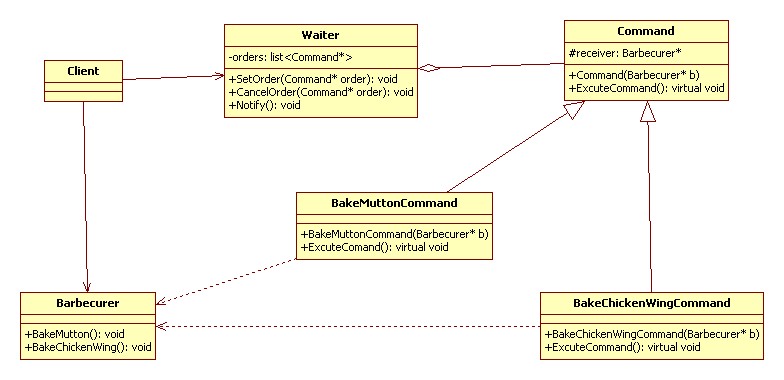
代码实现 C++:
1 #include <iostream>
2 #include <list>
3 #include <algorithm>
4 using namespace std;
5
6 class Barbecurer
7 {
8 public:
9 void BakeMutton()
10 {
11 cout << "烤羊肉串!" << endl;
12 }
13 void BakeChickenWing()
14 {
15 cout << "烤鸡翅!" << endl;
16 }
17 };
18
19 class Command
20 {
21 protected:
22 Barbecurer* receiver;
23 public:
24 Command(Barbecurer* b)
25 {
26 receiver = b;
27 }
28 virtual void ExcuteCommand() = 0;
29 };
30
31 class BakeMuttonCommand : public Command
32 {
33 public:
34 BakeMuttonCommand(Barbecurer* b) : Command(b) {}
35 virtual void ExcuteCommand()
36 {
37 receiver->BakeMutton();
38 }
39 };
40
41 class BakeChickenWingCommand : public Command
42 {
43 public:
44 BakeChickenWingCommand(Barbecurer* b) : Command(b) {}
45 virtual void ExcuteCommand()
46 {
47 receiver->BakeChickenWing();
48 }
49 };
50
51 class Waiter
52 {
53 private:
54 list<Command*> orders;
55 public:
56 void SetOrder(Command* order)
57 {
58 cout << "增加订单!" << endl;
59 orders.push_back(order);
60 }
61 void CancelOrder(Command* order)
62 {
63 list<Command*>::iterator iter = find(orders.begin(), orders.end(), order);
64 if (iter != orders.end())
65 {
66 cout << "取消订单!" << endl;
67 orders.erase(iter);
68 }
69 }
70 void Notify()
71 {
72 for (list<Command*>::iterator iter = orders.begin(); iter != orders.end(); ++iter)
73 {
74 (*iter)->ExcuteCommand();
75 }
76 }
77 };
78
79 int main()
80 {
81 Barbecurer* boy = new Barbecurer;
82
83 Command* bakeMuttonCommand1 = new BakeMuttonCommand(boy);
84 Command* bakeMuttonCommand2 = new BakeMuttonCommand(boy);
85 Command* bakeChickenWingCommand1 = new BakeChickenWingCommand(boy);
86
87 Waiter* girl = new Waiter;
88
89 girl->SetOrder(bakeMuttonCommand1);
90 girl->SetOrder(bakeMuttonCommand2);
91 girl->SetOrder(bakeChickenWingCommand1);
92
93 girl->Notify();
94
95
96 girl->CancelOrder(bakeMuttonCommand2);
97 girl->Notify();
98
99 return 0;
100 }
posted @
2011-04-29 21:15 unixfy 阅读(382) |
评论 (0) |
编辑 收藏来自于《大话设计模式》
桥接模式(Bridge):将抽象部分与它的实现部分分离,使它们都可以独立地变化。
结构型
UML 类图:

代码实现 C++:
1 #include <iostream>
2 using namespace std;
3
4 class HandsetSoft
5 {
6 public:
7 virtual void Run() = 0;
8 };
9
10 class HandsetGame : public HandsetSoft
11 {
12 public:
13 virtual void Run()
14 {
15 cout << "运行手机游戏!" << endl;
16 }
17 };
18
19 class HandsetAddressList : public HandsetSoft
20 {
21 public:
22 virtual void Run()
23 {
24 cout << "运行手机通讯录!" << endl;
25 }
26 };
27
28 class HandsetBrand
29 {
30 protected:
31 HandsetSoft* hs;
32 public:
33 HandsetBrand() : hs(0) {}
34 virtual ~HandsetBrand()
35 {
36 delete hs;
37 }
38 void SetHandsetSoft(HandsetSoft* soft)
39 {
40 delete hs;
41 hs = soft;
42 }
43 virtual void Run() = 0;
44 };
45
46 class HandsetBrandN : public HandsetBrand
47 {
48 public:
49 virtual void Run()
50 {
51 hs->Run();
52 }
53 };
54
55 class HandsetBrandM : public HandsetBrand
56 {
57 public:
58 virtual void Run()
59 {
60 hs->Run();
61 }
62 };
63
64 int main()
65 {
66 HandsetBrand* ab = new HandsetBrandN;
67
68 ab->SetHandsetSoft(new HandsetGame);
69 ab->Run();
70
71 ab->SetHandsetSoft(new HandsetAddressList);
72 ab->Run();
73
74 delete ab;
75
76 ab = new HandsetBrandM;
77
78 ab->SetHandsetSoft(new HandsetGame);
79 ab->Run();
80
81 ab->SetHandsetSoft(new HandsetAddressList);
82 ab->Run();
83
84 delete ab;
85
86 return 0;
87 }
posted @
2011-04-29 20:42 unixfy 阅读(335) |
评论 (0) |
编辑 收藏
来自于《大话设计模式》
单例模式(Singleton):保证一个类仅有一个实例,并提供访问它的全局访问点。类的实例化有类本身管理。
UML 类图:
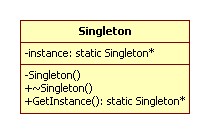
代码实现 C++:
1 #include <iostream>
2 using namespace std;
3
4 class Singleton
5 {
6 private:
7 static Singleton* instance;
8 Singleton() {}
9 public:
10 static Singleton* GetInstance()
11 {
12 if (instance == 0)
13 {
14 instance = new Singleton;
15 }
16 return instance;
17 }
18 ~Singleton()
19 {
20 delete instance;
21 }
22 };
23
24 Singleton* Singleton::instance = 0;
25
26 int main()
27 {
28 Singleton* s1 = Singleton::GetInstance();
29 Singleton* s2 = Singleton::GetInstance();
30
31 cout << s1 << endl;
32 cout << s2 << endl;
33
34 return 0;
35 }
posted @
2011-04-29 17:09 unixfy 阅读(238) |
评论 (0) |
编辑 收藏